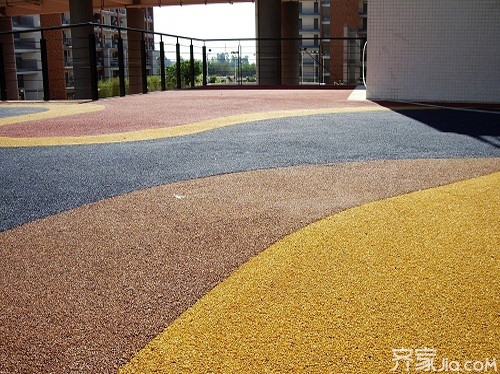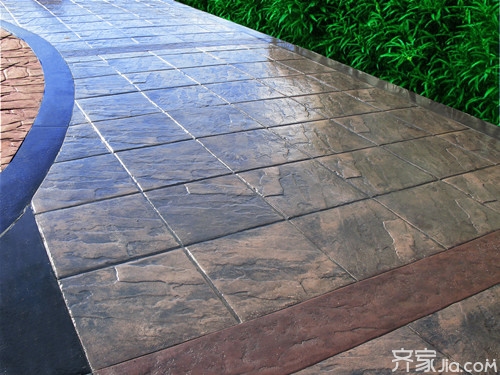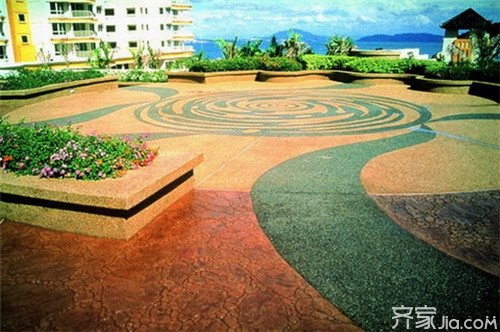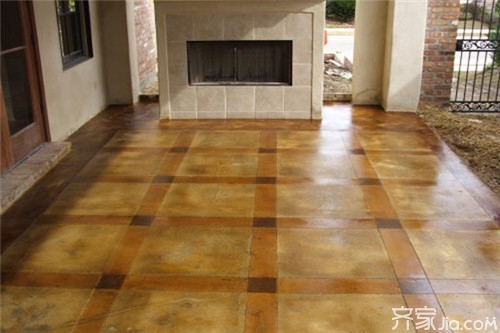The art floor can be used on the surface of concrete to produce rich colorful decorative surfaces with high strength and high abrasion resistance. It is also possible to decorate and transform the wall and the old ground. Then, what steps do you know about art floor practices ? Let's go down and check it out.
Which materials make up the art floor?

a) The reinforcing material is a colored powder chemical building material. This product is applied to the concrete surface of the initial setting stage and chemically reacts with the concrete. It strengthens and infiltrates the concrete surface, giving the concrete surface superior wear and compression resistance. Flexural properties, while giving ordinary concrete rich colors, due to its superior permeability and abrasion resistance and excellent UV resistance properties, making it easy to adhere to the surface of the concrete unlike paint or floor paint, effectively Shedding and wear are avoided, which greatly improves its decorative and durable properties.
(b) The color release powder is a colored, hydrophobic lightweight powder that can cover 100 square meters of art floor with only 15 kilograms. At the same time, it has a strong stripping effect, avoiding the mold imprint texture The moulding phenomenon that occurs at the time allows the floor mould to be easily demolded without damage to the coloured concrete surface. The use of demoulding powder and easy-to-use color reinforcing material can also play a secondary coloring and curing effect on the art floor.

[Art Floor Practice]
1. According to the drawings, the contractor shall establish a template on the periphery of the art floor. The height of the vertical mold shall be flush with the design elevation (no need to reserve the same height as the paving slab), and a well box shall be placed or buried underground.
2. The Employer shall provide on-site concrete paving, leveling for grade, leveling of Muha, and sufficient pulp. It is forbidden to add water to the paved concrete, keep the concrete water-cement ratio consistent with the slump, and pour it in order. After paving the concrete, it is assigned to the construction personnel of Yimei Color Stone Art Floor.
3. When there is no obvious water on the concrete surface, the construction personnel will spread the color reinforcing material evenly to the surface of the concrete. The spreading material shall be covered uniformly and spread as thick and thin as possible.
After the reinforcement material absorbs moisture, the construction worker uses the art spatula to harvest the surface of the art floor. The light requirements are smooth, there is no spatula mark, and the light is collected quickly.
4. When the surface color of the art floor becomes dark, when the surface of the floor is not hardened, all the color stripping powder is evenly distributed, and the spreading powder is scattered to make it thin and uniform, and it must be completely covered.
5. After confirming the direction of good mould discharge, the art floor stamp moulds shall be arranged in close order according to certain rules. The splicing requirements shall be tight and no gaps shall be left. At the same time, the moulds shall be placed one time at a time, and the moulds shall not be repeated and tested again. Placing and lifting the mold should also be vertical and it should not drag the mold.

6, according to the degree of concrete hardness, skilled workers can well grasp the strength of the mold and the depth of embossing, the softer parts of the concrete can be used foot, harder parts to be combined with hammer, so that imprint The lines that come out can be uniform in texture and consistent in depth and depth.
7. Close the area where the texture embossing is completed to prevent irremediable damage caused by irrelevant persons or vehicles. The artistic floor should be closed for at least 1 day in summer and be closed for 3 days in winter. However, the passage of vehicles should be prohibited. .
The flushing is usually done after the texture stamping of the artistic flooring works is completed, because the surface of the unwashed art floor is evenly covered by the stripping powder, which can effectively prevent the art floor from being contaminated with grout or other difficult-to-clean stains. .
8, wash with water and detergent or dishwashing detergent and floor brush to remove the mold powder on the surface of the art. The surface of the washed art floor still contains about 15% of the stripping powder, which cannot be washed off. The mold powder has a good effect of increasing the texture effect and color gradient of the art floor when the protective agent is last applied.

Xiao Bian concludes: The above introduced the art floor practices and hopes to help everyone. For more relevant knowledge, please continue to pay attention to this website information platform. Follow-up will present more exciting content for everyone.
Which materials make up the art floor?

a) The reinforcing material is a colored powder chemical building material. This product is applied to the concrete surface of the initial setting stage and chemically reacts with the concrete. It strengthens and infiltrates the concrete surface, giving the concrete surface superior wear and compression resistance. Flexural properties, while giving ordinary concrete rich colors, due to its superior permeability and abrasion resistance and excellent UV resistance properties, making it easy to adhere to the surface of the concrete unlike paint or floor paint, effectively Shedding and wear are avoided, which greatly improves its decorative and durable properties.
(b) The color release powder is a colored, hydrophobic lightweight powder that can cover 100 square meters of art floor with only 15 kilograms. At the same time, it has a strong stripping effect, avoiding the mold imprint texture The moulding phenomenon that occurs at the time allows the floor mould to be easily demolded without damage to the coloured concrete surface. The use of demoulding powder and easy-to-use color reinforcing material can also play a secondary coloring and curing effect on the art floor.

[Art Floor Practice]
1. According to the drawings, the contractor shall establish a template on the periphery of the art floor. The height of the vertical mold shall be flush with the design elevation (no need to reserve the same height as the paving slab), and a well box shall be placed or buried underground.
2. The Employer shall provide on-site concrete paving, leveling for grade, leveling of Muha, and sufficient pulp. It is forbidden to add water to the paved concrete, keep the concrete water-cement ratio consistent with the slump, and pour it in order. After paving the concrete, it is assigned to the construction personnel of Yimei Color Stone Art Floor.
3. When there is no obvious water on the concrete surface, the construction personnel will spread the color reinforcing material evenly to the surface of the concrete. The spreading material shall be covered uniformly and spread as thick and thin as possible.
After the reinforcement material absorbs moisture, the construction worker uses the art spatula to harvest the surface of the art floor. The light requirements are smooth, there is no spatula mark, and the light is collected quickly.
4. When the surface color of the art floor becomes dark, when the surface of the floor is not hardened, all the color stripping powder is evenly distributed, and the spreading powder is scattered to make it thin and uniform, and it must be completely covered.
5. After confirming the direction of good mould discharge, the art floor stamp moulds shall be arranged in close order according to certain rules. The splicing requirements shall be tight and no gaps shall be left. At the same time, the moulds shall be placed one time at a time, and the moulds shall not be repeated and tested again. Placing and lifting the mold should also be vertical and it should not drag the mold.

6, according to the degree of concrete hardness, skilled workers can well grasp the strength of the mold and the depth of embossing, the softer parts of the concrete can be used foot, harder parts to be combined with hammer, so that imprint The lines that come out can be uniform in texture and consistent in depth and depth.
7. Close the area where the texture embossing is completed to prevent irremediable damage caused by irrelevant persons or vehicles. The artistic floor should be closed for at least 1 day in summer and be closed for 3 days in winter. However, the passage of vehicles should be prohibited. .
The flushing is usually done after the texture stamping of the artistic flooring works is completed, because the surface of the unwashed art floor is evenly covered by the stripping powder, which can effectively prevent the art floor from being contaminated with grout or other difficult-to-clean stains. .
8, wash with water and detergent or dishwashing detergent and floor brush to remove the mold powder on the surface of the art. The surface of the washed art floor still contains about 15% of the stripping powder, which cannot be washed off. The mold powder has a good effect of increasing the texture effect and color gradient of the art floor when the protective agent is last applied.

Xiao Bian concludes: The above introduced the art floor practices and hopes to help everyone. For more relevant knowledge, please continue to pay attention to this website information platform. Follow-up will present more exciting content for everyone.
How to avoid renovation contract trap indoor production tutorial
Din936 Hex Thin Nut,Customized Hexagon Jam Nuts,Custom Made Hexagon Thin Nuts,Non-Standard Hexagon Thin Nuts
Chuangtuo Jinggong (Jiangsu) Co., LTD , https://www.chtofastener.com